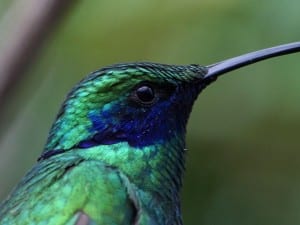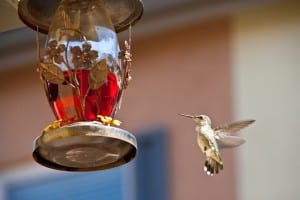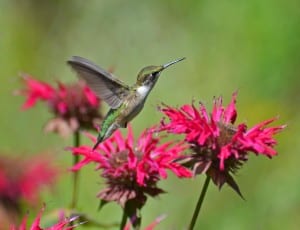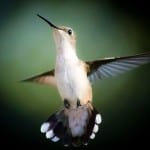This time of year, when the oranges and reds of summer blooms are punctuating our yards, we may receive a special treat as we are looking out the window or enjoying some time out in the garden. We have to look fast or we might miss it. Something flits and flutters by with amazing speed. We almost go cross-eyed as we try to follow it’s flight pattern. Finally it slows, just a hair, just enough for the blur to come into focus. A hummingbird! We shout out our discovery to anyone who is within earshot, and also to those who are not. It doesn’t matter how may times we gaze upon these tiny creatures, they always amaze us. Think about it, the last time you saw one, didn’t you look around for someone to share in the delight? It’s no wonder that here at the nurseries we highlight plants that will attract these amazing creatures; we want you to be able to have a smile each and every day when they come to visit your home. So today I want to take a little time to chat about my favorite, miniscule, feathered friend, the hummingbird.
(Hummingbird feeders along with attractor plants will have these tiny friends visiting all summer.)
What is it that endears the hummingbird to me so much? They are tiny, for one, and we all know that everything is cuter when it is in a tiny form. Who can resist a puppy or kitten? Maybe the hummingbird reminds me of a baby bird, they are the smallest bird in the world after all. A hummingbird can weigh between 2-20 grams. Grams! A penny only weighs 2.5 grams. Put about 8 pennies in your hand and it would be the equivalent of holding the largest hummingbird! 1 penny equals a baby hummingbird! Astounding? Yes, but I don’t think the the sheer tininess of the hummingbird is it’s most endearing quality.
(Eight pennies worth!)
Maybe it is how they eat that is so heartwarming. It starts with that crazy beak. I love how they poke around in our flowers and lap up the nectar with their “w” shaped, hairy-tipped tongue. That beak is truly astounding. The bottom half of the beak is slightly flexible and really allows the hummingbird to maneuver it’s tongue to get the nitty-gritty out of those tight, tubular-shaped flowers, and barely leave a drop of nectar behind. And as they are eating, they are also pollinating the flowers. They rub their face and forehead in each flower as they eat, how extremely cute is that? Yes, the way they eat is wonderful, but that’s still not exactly my favorite part.
(About to dive in for a meal.)
I love when I get the chance to really see the colors of the hummingbird’s feathers. Again, I have to look fast, but if I’m lucky, the sun will shine on them with the right angle and I will be rewarded with bright, radiant color. It comes from iridescent coloring, like the colors you see in prisms, or soap bubbles. Rainbows, prisms, soap bubbles and hummingbird wings make me happy for sure, but the coolest thing about those colors is that the hummingbird can flash them when it wants to, and hide them when it needs to. Ahhhh…. I think we are getting closer to what it is about the hummingbird that I love so much.
(Decided to show his colors today.)
They are smart! They are so smart! That’s the fact about the hummingbird that makes my heart flutter as fast as their wings. Maybe I think they are so smart because their brain takes up 4.2% of it’s body weight (the largest proportion in the bird kingdom, by the way). Maybe I think they are so smart because they can see further and hear better than humans. Whatever it is, these tiny birds are no dummies. They can remember EVERY single flower that they have been to and slurped from, and they know just how long they need to wait to go back to it. I can’t remember how much milk is left in the carton that I just poured from. They actually know how long it takes for the flower to fill back up with nectar. Smarties! They also are no sloths. You will find the hummingbird either flying or perching. They can’t really walk because they have weak feet. But even while they are perching, they are not really resting. A hummingbird’s heart will beat 250 times per minute, and it will take 250 breaths per minute AT REST! Yes, that means while it is just perched and resting it’s wings, the hummingbird is still being extremely active. A hummingbird will eat anywhere from half to eight times its body weight each day! No wonder it’s metabolism is about 100 times that of an elephant, and no wonder the hummingbird needs to eat around 7 times per hour to keep it alive. This means visiting an average of 1,000 flowers per day. I get tired when I have to go to the grocery store AND the mailbox! So, yes, I believe I have honed in on what I love about the hummingbird the most. It is their intelligence and their determination and energy.
(Wings beating so fast, in a blur of speed.)
Now that I’ve told you what I love most about hummingbirds, I think we should visit what hummingbirds love most. They love bright colors, and their favorite is red. It really attracts them and gives them hope that something yummy is nestled in that color. This is why you find most hummingbird feeders encased in some type of red plastic or red glass, or why some hummingbird nectar you buy is dyed red. It’s the color that attracts them, not the scent of the sugar water, or the flower. As a matter of fact, hummingbirds have no sense of smell. But they will hone in on color, even if sometimes they don’t make the distinction between a colorful flower and a colorful non-flower. I say this, because it pained my heart once to watch a little hummingbird flit desperately around trying to retrieve nectar from some fluorescent-colored clothespins I had out on a clothesline once. But remember, because they are so smart I know it won’t be trying that again!
(Must be something good inside!)
Another favorite of the hummingbird is those plants that have tubular-shaped flowers. Think of plants like the Flame Acanthus, Hummingbird Bush, Cigar Plant, Bee Balm, Agastache, Cape Honeysuckle, Firespike, Pineapple Sage, Turk’s Cap, and Salvia greggiis. Combine the color red with a tubular-shaped flower, and you’ll be hearing the hum of the hummingbird’s wings all summer long. This is just the tip of a list that can have these smarties flocking to your garden. I hope this blog has inspired you to take a look around your landscape and see where you can plant one of these attractors so that you will be able to delight in the miraculous world of the hummingbird.
(Spikes of Bee balm blooms just made this hummingbird’s day.)
“may my faith always be
at the end of the day
like a hummingbird…returning
to its favorite flower.”~ Sanober Khan Turquoise Silence
-The Happy Gardener
-Lisa Mulroy









Hi,
I just love your nursery! I’m interested in shade loving potted plants for my patio that will attract hummingbirds. Bright blooms preferred. 🙂 My patio hardly gets any sun.
What do you carry that you would recommend?
Thanks,
Monique
We’ve got a couple different info sheets that could help. When your patio does get sun, when and how long exactly? Off the top of my head for shade plants to attract humming birds: Betony, Lyre leaf sage, Cardinal Flower, Firespike and Coral Bells. Some others that could work depending on the amount of light that does come in: Mex. Oregano,Batface Cuphea,Shrimp plant. I’ll attach our shade plant handout and you could look up a few depending on your light availability. Shade Plant Handout
LOVE THIS!!!💜
Thank you so much Kim! Appreciate you taking the time to read it.